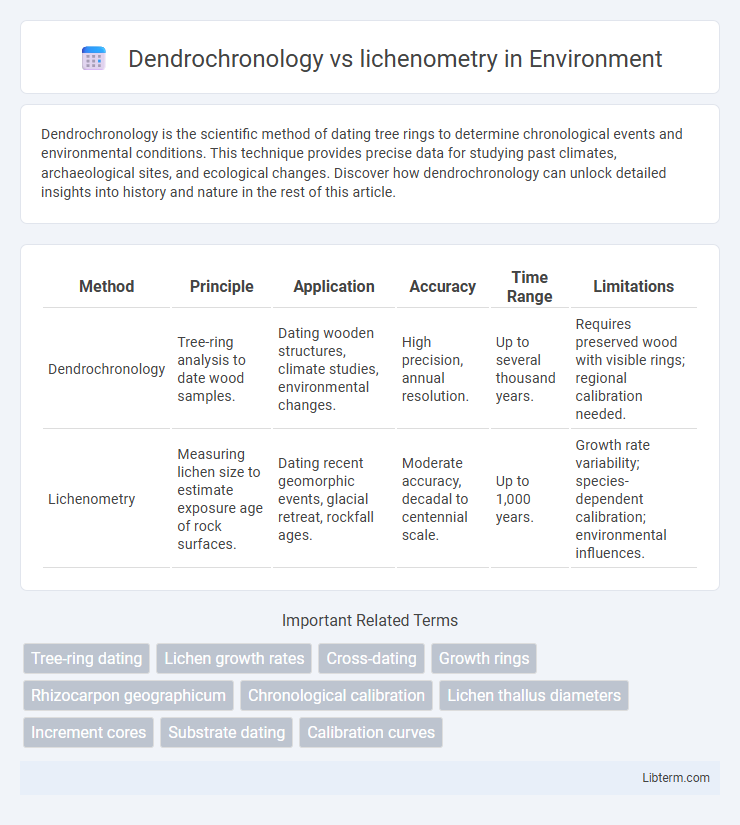Dendrochronology is the scientific method of dating tree rings to determine chronological events and environmental conditions. This technique provides precise data for studying past climates, archaeological sites, and ecological changes. Discover how dendrochronology can unlock detailed insights into history and nature in the rest of this article.
Table of Comparison
| Method | Principle | Application | Accuracy | Time Range | Limitations |
|---|---|---|---|---|---|
| Dendrochronology | Tree-ring analysis to date wood samples. | Dating wooden structures, climate studies, environmental changes. | High precision, annual resolution. | Up to several thousand years. | Requires preserved wood with visible rings; regional calibration needed. |
| Lichenometry | Measuring lichen size to estimate exposure age of rock surfaces. | Dating recent geomorphic events, glacial retreat, rockfall ages. | Moderate accuracy, decadal to centennial scale. | Up to 1,000 years. | Growth rate variability; species-dependent calibration; environmental influences. |
Introduction to Dendrochronology and Lichenometry
Dendrochronology is the scientific method of dating tree rings to analyze chronological sequences and environmental conditions over time. Lichenometry estimates the age of exposed rock surfaces by measuring lichen growth, providing a timeline for geological and archaeological studies. Both techniques offer crucial data for understanding historical and environmental changes but apply distinct biological markers for dating purposes.
Principles of Dendrochronology
Dendrochronology is based on analyzing tree ring patterns to date events and environmental changes with annual precision. Each ring represents one year of growth, reflecting climatic conditions, making it a reliable method for calibrating radiocarbon dates and studying past climate. In contrast, lichenometry measures lichen growth on exposed rock surfaces, offering relative dating over shorter timescales but with less temporal resolution.
Fundamentals of Lichenometry
Lichenometry is a geochronological method that estimates the exposure age of rock surfaces by measuring lichen thallus diameters, relying on the predictable growth rates of specific lichen species such as Rhizocarpon geographicum. This technique assumes that lichens colonize fresh rock surfaces shortly after exposure, with their size directly correlating to the substrate's exposure duration. Unlike dendrochronology, which analyzes tree ring patterns for dating, lichenometry is especially valuable in dating surfaces in alpine, arctic, and barren environments where trees are sparse or absent.
Methods of Data Collection
Dendrochronology utilizes tree ring analysis by extracting core samples from living or dead trees to measure annual growth layers, providing precise chronological dating. Lichenometry involves measuring the size of lichen colonies on exposed rock surfaces to estimate the duration of exposure, relying on known growth rates of specific lichen species. Both methods require careful site selection and environmental consideration to ensure accurate temporal data for geological and archaeological studies.
Applications in Environmental and Geological Studies
Dendrochronology provides precise dating of wooden artifacts and past climatic conditions by analyzing tree ring patterns, crucial for reconstructing environmental histories and assessing geological events such as volcanic eruptions or earthquakes. Lichenometry estimates surface exposure ages by measuring lichen growth on rocks, offering valuable timelines for glacial retreat, landslides, and moraine stabilization in geological studies. Both methods complement each other by providing chronological frameworks essential for understanding landscape evolution and climate change impacts.
Advantages of Dendrochronology
Dendrochronology offers precise dating by analyzing tree ring patterns, providing exact calendar years for samples, unlike lichenometry, which estimates age based on lichen growth rates with more variability. It allows reconstruction of past climatic conditions and environmental changes through annual growth rings, delivering detailed historical data. The method is highly replicable and can be applied to a broad range of wood samples, increasing its reliability for archaeological and ecological research.
Strengths of Lichenometry
Lichenometry offers valuable advantages in dating exposed rock surfaces over time spans of decades to centuries, especially in areas lacking organic material for radiocarbon or dendrochronological analysis. The method relies on measuring the size of lichen colonies, which grow at relatively predictable rates, making it effective for dating glacial moraines, landslides, and other geomorphological features. Its application is particularly strong in arid and alpine environments where tree growth is limited or absent, offering a cost-effective and rapid dating technique compared to dendrochronology.
Limitations and Challenges of Both Techniques
Dendrochronology faces limitations such as the requirement for well-preserved tree-ring records and difficulty in dating events beyond the lifespan of sampled trees, while environmental factors can cause variations in ring growth that affect accuracy. Lichenometry encounters challenges including species-specific growth rates that vary regionally, calibration issues, and the influence of environmental conditions like moisture and temperature on lichen development. Both techniques require careful contextual interpretation and calibration to minimize dating errors and improve reliability in environmental and archaeological research.
Comparative Analysis: Dendrochronology vs Lichenometry
Dendrochronology and lichenometry are both reliable dating techniques used in geological and archaeological studies, yet they differ significantly in methodology and application. Dendrochronology analyzes tree-ring growth patterns to date wooden artifacts or environmental events precisely, often with annual resolution, while lichenometry estimates surface exposure age by measuring lichen colony size growth rates, typically effective over centuries to millennia. Each method's accuracy depends on environmental conditions and material availability, making them complementary in reconstructing past landscapes and dating features in exposed rock or wooden structures.
Future Directions and Innovations
Emerging advancements in dendrochronology emphasize high-resolution imaging and AI-powered pattern recognition to enhance tree-ring dating accuracy. Lichenometry benefits from improved satellite-based spectral analysis and machine learning models to refine age estimations in diverse environments. Integrating multi-proxy data sources promises innovative cross-disciplinary applications in climate change research and geochronology.
Dendrochronology Infographic

 libterm.com
libterm.com